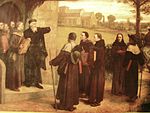Utraquism

Utraquism (from the Latin sub utraque specie, meaning "under both kinds"), also called Calixtinism (from chalice; Latin: calix, borrowed from Greek kalyx, shell, husk; Czech: kališníci), was a belief amongst Hussites, a reformist Christian movement, that communion under both kinds (both bread and wine, as opposed to the bread alone) should be administered to the laity during the celebration of the Eucharist.[1] It was a principal dogma of the Hussites and one of the Four Articles of Prague.[2]
After the Hussite movement split into various factions early in the Hussite Wars, Hussites that emphasized the laity's right to communion under both kinds became known as Moderate Hussites, Utraquist Hussites, or simply Utraquists. The Utraquists were the largest Hussite faction.
History
[edit]
Utraquism was a Christian dogma first proposed by Jacob of Mies, professor of philosophy at the University of Prague, in 1414.[2] It maintained that the Eucharist should be administered "under both kinds"[1] — as both bread and wine — to all the congregation, including the laity. The practice among Roman Catholics at the time was for only the priests to partake of the consecrated wine, the Precious Blood.[2]
Jacob taught that communion should be provided and taken under both kinds, which as a precept of Christ could not be changed by the church. Only those who received the utraquist (both kinds) communion belong to the church of Christ.[3]: 51 There is disagreement in sources about whether he, or early Utraquists, taught this was necessary for salvation[4]: 180 (as claimed by Catholic detractors such as Andrew of Brod), or necessary to receive the salvific effect of the eucharist[4]: 174 or an obligation.[5]: 518
The 15th century Utraquists were a moderate faction of the Hussites with strong respect for the sacrament and, generally, endorsed transubstantiation and Catholicity[6] (in contrast to the more radical Taborites, Orebites and Orphans who were closer to the beliefs of John Wycliffe). They were also known as the Prague Party or the Calixtines — from calix, Latin for their emblem, the chalice.[2]
The Utraquists eventually allied themselves with the Catholic forces (following the Council of Basel) and defeated the more radical Taborites and Orphans at the Battle of Lipany in 1434.[2] After that battle, nearly all forms of Hussite revival were Utraquist, as seen with George of Poděbrady, who even managed to cause the town of Tábor, the famous Taborite stronghold, to convert to Utraquism.[citation needed]
An agreement of mutual accommodation was agreed in 1485 between Catholics and Utraquists: the religious peace of Kutná Hora ended the Hussite wars. Following the victory of allied Utraquist and Catholic forces in the Hussite Wars, Utraquists constituted a majority of the Bohemian lands.
Further development
[edit]In the 16th century much of the population then adopted the pre-Lutheran Protestant Unity of the Brethren and Lutheranism; the Utraquist Church remained strong in the cities.
The Battle of White Mountain, in 1620, marked the end of the Bohemian Revolt and, led to recatholization in the Lands of the Bohemian Crown. In 1627, communion under both kinds was again not made available, until the eventual Josephinian Patent of Toleration in 1781.
In modern Catholic practice since the Second Vatican Council, it is determined by each local bishop whether communion is available in one or both kinds in their diocese.
See also
[edit]References
[edit]- ^ a b Wood 1907.
- ^ a b c d e Hughes 1915.
- ^ Cermanová, Pavlína (2018). "Jakoubek of Stříbro's Czech Výklad Na Zjevenie and Its Latin Reception in Hussite Exegetical Texts". Listy filologické / Folia philologica. 141 (1/2): 45–73. ISSN 0024-4457.
- ^ a b Levy, Ian Christopher (2017). "Interpreting the Intention of Christ: Roman Responses to Bohemian Utraquism from Constance to Basel". Europe After Wyclif. Fordham University Press: 173–195.
- ^ Patapios, Hieromonk (2002). "Sub Utraque Specie: The Arguments of John Hus and Jacoubek of Stříbro in Defence of Giving Communion to the Laity Under Both Kinds". The Journal of Theological Studies. 53 (2): 503–522. ISSN 0022-5185.
- ^ "Utraquism’s faithfulness to the Prague Use of the Roman rite…(was) an intentional symbol of Utraquism’s self-understanding as a continuing part of the Western Catholic Church." Holeton, David R.; Vlhová-Wörner, Hana; Bílková, Milena (2007). "The Trope Gregorius presul meritis in Bohemian Tradition: Its Origins, Development, Liturgical Function and Illustration" (PDF). Bohemian Reformation and Religious Practice. 6: 215–246. Retrieved 18 November 2023.
Bibliography
[edit]- Ogden, C. K.; Richards, I. A. (1989) [1923]. "Chapter VI: The Theory of Definitions". The Meaning of Meaning. Harcourt Brace Jovanovich. ISBN 0-15-658446-8.
 This article incorporates text from a publication now in the public domain: Hughes, Joseph (1915). "Utraquism". In Herbermann, Charles (ed.). Catholic Encyclopedia. Vol. 15. New York: Robert Appleton Company.
This article incorporates text from a publication now in the public domain: Hughes, Joseph (1915). "Utraquism". In Herbermann, Charles (ed.). Catholic Encyclopedia. Vol. 15. New York: Robert Appleton Company. This article incorporates text from a publication now in the public domain: Wood, James, ed. (1907). "Utraquists". The Nuttall Encyclopædia. London and New York: Frederick Warne.
This article incorporates text from a publication now in the public domain: Wood, James, ed. (1907). "Utraquists". The Nuttall Encyclopædia. London and New York: Frederick Warne.

